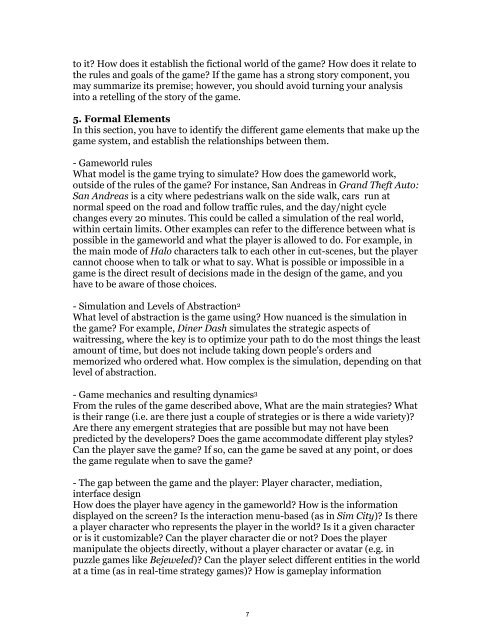MITCMS_300F11_GameAnaGuide
MITCMS_300F11_GameAnaGuide
MITCMS_300F11_GameAnaGuide
Create successful ePaper yourself
Turn your PDF publications into a flip-book with our unique Google optimized e-Paper software.
to it How does it establish the fictional world of the game How does it relate to<br />
the rules and goals of the game If the game has a strong story component, you<br />
may summarize its premise; however, you should avoid turning your analysis<br />
into a retelling of the story of the game.<br />
5. Formal Elements<br />
In this section, you have to identify the different game elements that make up the<br />
game system, and establish the relationships between them.<br />
- Gameworld rules<br />
What model is the game trying to simulate How does the gameworld work,<br />
outside of the rules of the game For instance, San Andreas in Grand Theft Auto:<br />
San Andreas is a city where pedestrians walk on the side walk, cars run at<br />
normal speed on the road and follow traffic rules, and the day/night cycle<br />
changes every 20 minutes. This could be called a simulation of the real world,<br />
within certain limits. Other examples can refer to the difference between what is<br />
possible in the gameworld and what the player is allowed to do. For example, in<br />
the main mode of Halo characters talk to each other in cut-scenes, but the player<br />
cannot choose when to talk or what to say. What is possible or impossible in a<br />
game is the direct result of decisions made in the design of the game, and you<br />
have to be aware of those choices.<br />
- Simulation and Levels of Abstraction 2<br />
What level of abstraction is the game using How nuanced is the simulation in<br />
the game For example, Diner Dash simulates the strategic aspects of<br />
waitressing, where the key is to optimize your path to do the most things the least<br />
amount of time, but does not include taking down people's orders and<br />
memorized who ordered what. How complex is the simulation, depending on that<br />
level of abstraction.<br />
- Game mechanics and resulting dynamics 3<br />
From the rules of the game described above, What are the main strategies What<br />
is their range (i.e. are there just a couple of strategies or is there a wide variety)<br />
Are there any emergent strategies that are possible but may not have been<br />
predicted by the developers Does the game accommodate different play styles<br />
Can the player save the game If so, can the game be saved at any point, or does<br />
the game regulate when to save the game<br />
- The gap between the game and the player: Player character, mediation,<br />
interface design<br />
How does the player have agency in the gameworld How is the information<br />
displayed on the screen Is the interaction menu-based (as in Sim City) Is there<br />
a player character who represents the player in the world Is it a given character<br />
or is it customizable Can the player character die or not Does the player<br />
manipulate the objects directly, without a player character or avatar (e.g. in<br />
puzzle games like Bejeweled) Can the player select different entities in the world<br />
at a time (as in real-time strategy games) How is gameplay information<br />
7


